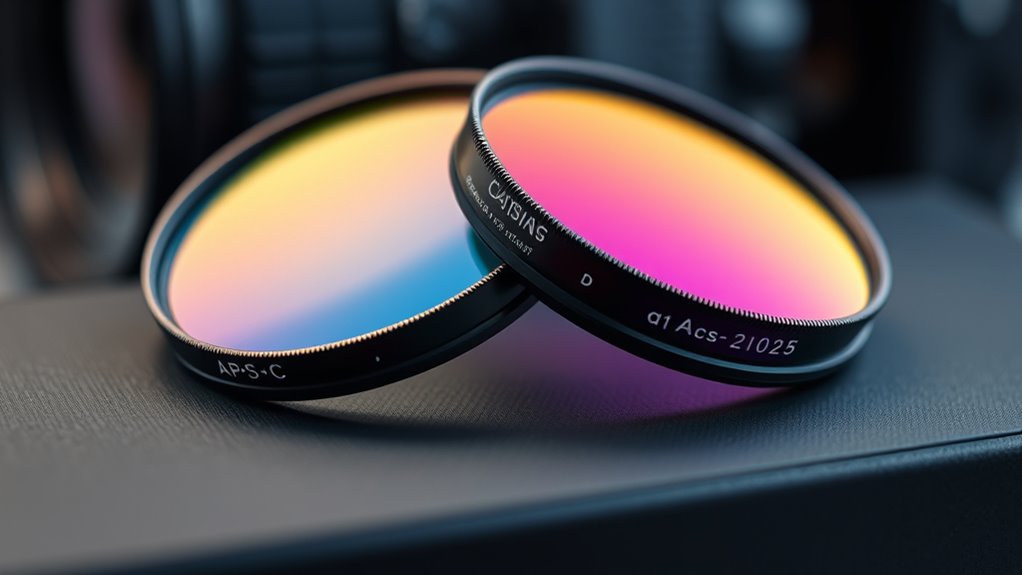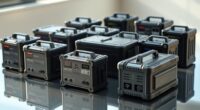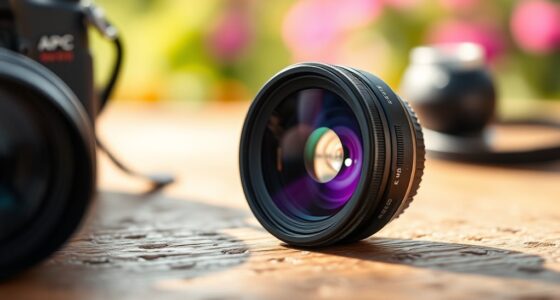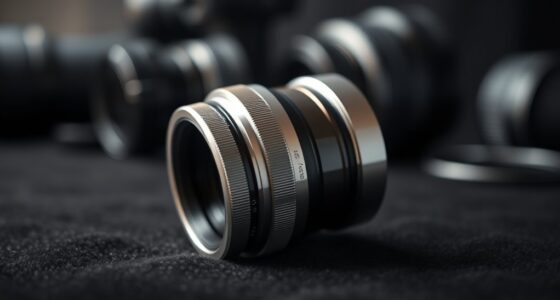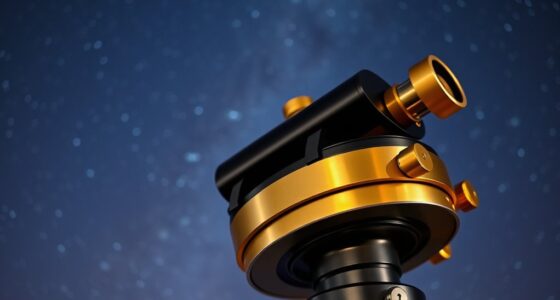If you’re looking for the best APS-C duo-band filters in 2025, I recommend the Askar Colour Magic Ultra E2 and the C1 filters. Both excel at enhancing image clarity and contrast by specifically transmitting key emission lines like Hα, OIII, and SII, while blocking light pollution. Their durable build and high transmittance make them ideal for deep-sky imaging. Keep exploring, and you’ll discover how these filters can transform your astrophotography results.
Key Takeaways
- Select filters like the Askar Colour Magic C1 designed specifically for APS-C cameras, offering high transmittance at key emission lines.
- Prioritize duo-band filters with narrow (~3nm) bandwidths to maximize contrast and light pollution rejection for clearer images.
- Ensure filters transmit essential emission lines (Hα at 656.6nm, OIII at 500.7nm) for detailed deep-sky astrophotography.
- Opt for filters with durable multi-layer coatings and high-quality materials to maintain optical clarity and longevity.
- Consider filters with high transmittance (>85%) and excellent light pollution suppression for superior image detail in urban environments.
Askar Colour Magic Ultra E2 Narrowband Duo-Band Filter
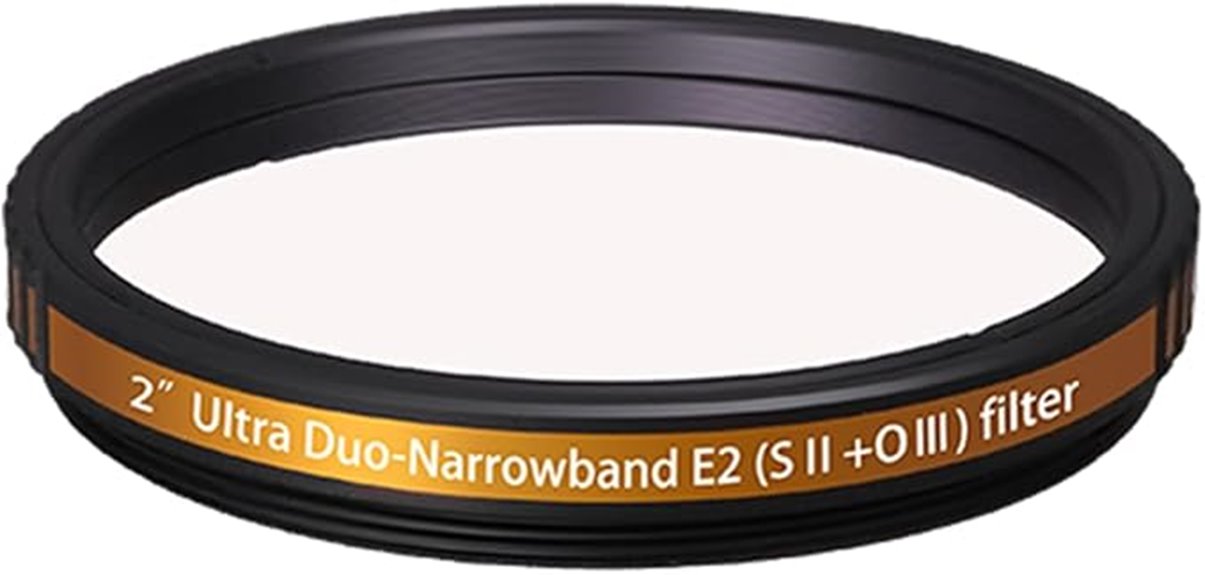
If you’re an astrophotographer aiming to capture detailed deep-sky images, the Askar Colour Magic Ultra E2 Narrowband Duo-Band Filter is an excellent choice. This 2-inch filter enhances contrast and reduces light pollution, allowing me to reveal faint nebulae and galaxy details more clearly. Its high transmittance of over 85% at 500.7nm (OIII) and 672nm (SII) ensures bright, sharp images. The filter’s ultra halo control and precise 3nm bandwidth enable me to isolate nebula emissions effectively. Compatible with both color and mono cameras, it’s perfect for capturing vibrant, high-contrast deep-sky objects even in light-polluted environments.
Best For: astrophotographers seeking high-contrast, detailed images of nebulae and galaxies in light-polluted areas using both color and mono cameras.
Pros:
- High transmittance over 85% at key emission lines (OIII and SII) for bright, sharp images
- Ultra halo control with a precise 3nm bandwidth enhances emission line isolation
- Effectively reduces light pollution, revealing faint celestial details even in challenging environments
Cons:
- As a specialized filter, it may be more expensive than broad-spectrum options
- Requires compatibility with 2-inch filter holders and appropriate camera setups
- Narrow bandwidth filters demand precise focusing and may limit brightness in some conditions
Askar Colour Magic C1 Duo-Band Filter for Nebula Imaging

The Askar Colour Magic C1 Duo-Band Filter is an excellent choice for astrophotographers using APS-C cameras who want to capture stunning nebula images even in light-polluted skies. It transmits over 90% at its core wavelengths—500.7nm (OIII) and 656.6nm (Hα)—maximizing contrast and detail. This dual-band filter effectively darkens the sky background, reducing interference from city lights and streetlights. Its design simplifies post-processing and produces sharp, high-quality images of gaseous and planetary nebulae. Easy to use and highly effective, the C1 filter is perfect for both visual observation and astrophotography, especially in challenging light-polluted environments.
Best For: amateur and professional astrophotographers using APS-C cameras who want to capture detailed nebula images in light-polluted environments.
Pros:
- Transmits over 90% at key wavelengths (OIII and Hα), enhancing contrast and detail.
- Effectively reduces light pollution from city lights and streetlights, improving image clarity.
- Easy to use with sharp, high-quality images suitable for both observation and astrophotography.
Cons:
- Slight discrepancies in VAT and customs charges for non-EU buyers may occur.
- Limited to 2-inch size, which may not fit all telescope setups without adapters.
- Customer reviews, while positive, are based on a small sample size of 7, so long-term durability is less documented.
Factors to Consider When Choosing Aps C Duo Band Filter
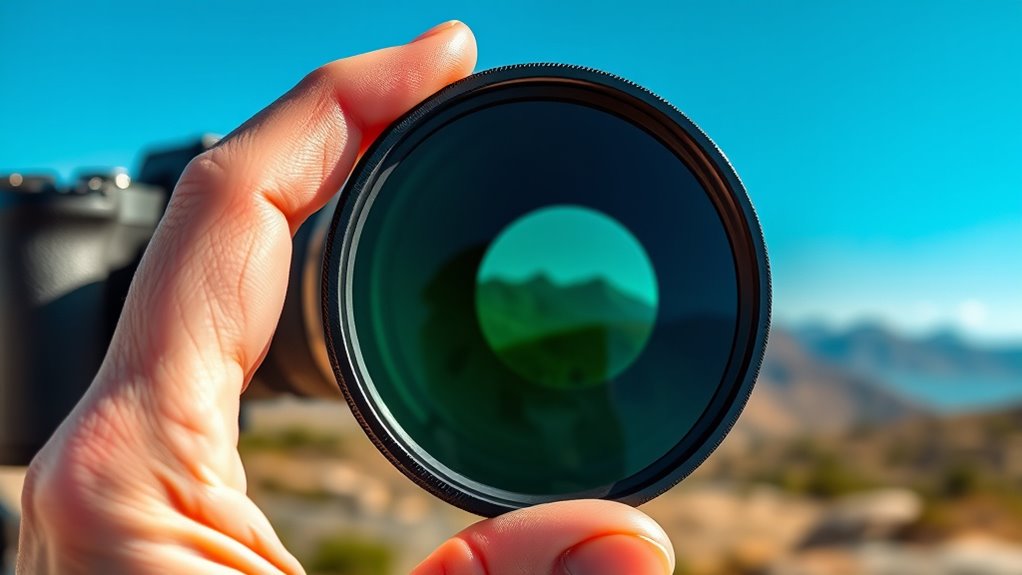
When selecting an APS-C duo band filter, I focus on factors like emission line compatibility and bandwidth to guarantee it matches my target objects. I also consider how well it rejects light pollution and how easily it integrates with my camera setup. Ultimately, I want a filter that boosts image contrast without sacrificing transmittance or introducing complications.
Emission Line Compatibility
Choosing the right APS-C duo band filter hinges on ensuring its emission lines match the specific wavelengths I want to capture. I need to verify that the filter transmits key lines like OIII at 500.7nm and SII at 672nm, which are essential for detailed nebula imaging. Since these filters are designed to transmit two emission lines simultaneously while blocking other wavelengths, compatibility with my camera’s spectral sensitivity is crucial to maximize transmission efficiency. Some filters combine lines like Hα with OIII, while others focus on SII and OIII; knowing which lines I need helps me select the most effective filter. Proper emission line compatibility minimizes unwanted light, reduces noise, and ultimately enhances the clarity and contrast of my deep-sky images.
Bandwidth and Transmittance
How does bandwidth influence the effectiveness of an APS-C duo band filter? Bandwidth determines the range of wavelengths that the filter allows, directly affecting its ability to isolate specific emission lines like OIII and SII. Narrower bandwidths, around 3nm, offer higher contrast by blocking more unwanted light, but they can also reduce overall signal strength, making images dimmer. Conversely, higher transmittance percentages—above 85%—mean more light passes through, resulting in brighter, more detailed images. Balancing bandwidth and transmittance is vital; too narrow a bandwidth might cut out valuable signal, while too broad can let in unwanted light. Optimizing these factors ensures clearer images with better contrast, detail, and a stronger signal-to-noise ratio in astrophotography.
Light Pollution Rejection
Ever wonder what makes a dual-band filter effective at reducing light pollution? It’s all about selective transmission—only allowing specific emission lines like Hα, OIII, and SII to pass through while blocking unwanted wavelengths from city lights and street illumination. Filters with high optical density and narrow bandwidths, around 3nm, do a better job of diminishing sky glow and artificial light interference, improving contrast considerably. This precise isolation minimizes background brightness, making faint deep-sky objects more visible even in heavily light-polluted areas. Proper light pollution rejection is vital for astrophotographers aiming to capture detailed images under challenging conditions. By choosing a filter with these qualities, I can greatly enhance image clarity and reveal celestial details that would otherwise be hidden by urban light pollution.
Camera Integration Ease
When selecting an APS-C duo band filter, ensuring compatibility with your camera’s mount size is essential for smooth integration. Most cameras use a 2-inch mount, so double-check that the filter fits perfectly without needing adapters. Ease of attachment and removal is also important; look for filters that can be easily attached or detached without tools. Additionally, verify that the filter’s optical coatings are compatible with your sensor type, whether monochrome or color, to prevent any imaging issues. Transmission wavelengths should align with your camera’s capabilities, ensuring maximum efficiency. Finally, consider whether the design allows straightforward stacking with other filters or accessories, which can simplify your setup and enhance your astrophotography experience.
Image Contrast Enhancement
Choosing the right APS-C duo band filter can markedly boost your astrophotography results by enhancing image contrast. These filters work by selectively transmitting specific emission lines, like OIII and SII, while blocking unwanted wavelengths, especially light pollution. This selective transmission darkens the sky background, making faint nebulae and details stand out sharply. The narrow bandwidth, typically around 3nm, ensures high contrast by isolating these emission lines precisely. Additionally, high transmittance—often over 85%—means brighter, more detailed images without sacrificing clarity. Properly used, duo-band filters reveal intricate structures within nebulae that are often hidden under light-polluted or moonlit skies. Overall, they substantially improve contrast, helping you capture cleaner, more striking astrophotographs.
Durability and Build Quality
Durability and build quality are vital factors to contemplate because they determine how well your APS-C duo band filter will perform over time. A well-made filter can withstand frequent handling, cleaning, and installation without degrading. High-quality materials, like metal housings and reinforced glass, help prevent warping, cracking, or corrosion that could impair image quality. Precise manufacturing tolerances are indispensable for maintaining consistent optical alignment, avoiding light leaks, and preventing ghosting. Resistance to environmental factors such as humidity, temperature changes, and dust ensures the filter remains reliable in various observing conditions. Additionally, filters with multi-layer coatings not only boost durability but also preserve high transmittance and contrast. Choosing a robust, well-constructed filter guarantees long-term performance and consistent image clarity.
Frequently Asked Questions
How Do Narrowband Duo-Band Filters Improve Image Contrast?
Narrowband duo-band filters improve image contrast by blocking out most unwanted wavelengths, allowing only specific bands of light to reach my camera sensor. This selective filtering enhances the contrast between celestial objects and the background sky, making details pop. By reducing light pollution and sky glow, I get clearer, more vivid images with sharper contrast, which is especially helpful for capturing faint objects like nebulae and galaxies.
Can These Filters Be Used With All APS-C Camera Models?
Yes, these filters can be used with most APS-C camera models, but you’ll want to check your camera’s filter thread size first. Most APS-C cameras have standard lens threads, making compatibility straightforward. Just make certain you select a filter with the right diameter. Keep in mind, some specialty filters might require adapters, so double-check your camera and lens specifications before purchasing to guarantee perfect fit and peak performance.
What Is the Typical Lifespan of High-Quality Duo-Band Filters?
Think of a high-quality duo-band filter as a guardian standing watch over your images. Typically, these filters last around 5 to 10 years, depending on usage and care. I’ve found that gentle cleaning and proper storage extend their life. So, if you treat them like a trusted companion, they’ll serve you well, capturing sharp visuals and vibrant colors for many seasons to come.
Are There Any Compatibility Issues With Specific Telescope Types?
Yes, some filters may have compatibility issues with certain telescopes, especially if the telescope’s focuser or mounting threads don’t match the filter’s threading size. I always double-check the filter’s specifications against my telescope’s connections to guarantee a snug fit and proper alignment. Using adapters can help, but it’s best to choose filters designed for your specific telescope type to avoid any issues and get the best image quality.
How Do Filter Coatings Affect Image Clarity and Accuracy?
Filter coatings play a crucial role in enhancing image clarity and accuracy. They reduce reflections and glare, which can distort your view, and improve light transmission through the filter. High-quality coatings also minimize unwanted color shifts, ensuring your images stay true to reality. When choosing a filter, I always look for well-coated options, as they make a noticeable difference in capturing crisp, detailed, and accurate images.
Conclusion
Just like a master painter chooses the perfect palette, selecting the right duo-band filter can transform your astrophotography. With these top contenders, you’ll gain access to stunning clarity and detail, turning your night sky into a masterpiece. Remember, it’s not just about capturing stars, but about crafting a vision as timeless as the universe itself. So, equip yourself wisely—your cosmic canvas awaits your touch.
